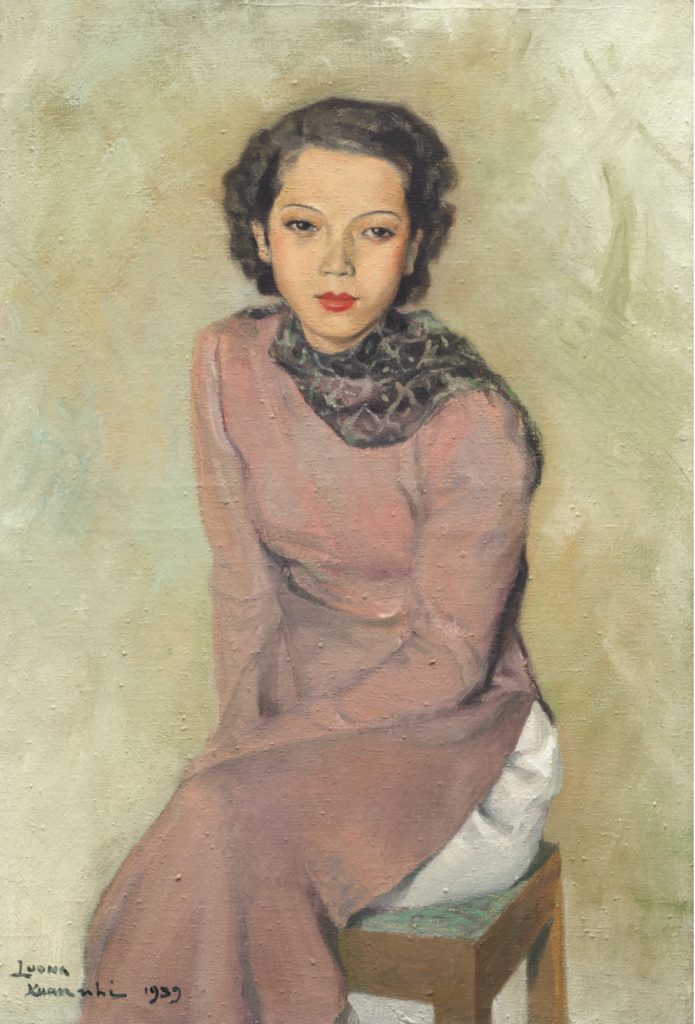Luong Xuan Nhi, circa 1939, “Au marché aux fleurs de pécher” (At the peach flower market), or discussion is not yet confrontation
To experience this rare work, you need to have experienced the enchanting scents of flower markets in the cool of the morning in Tonkin or Annam during the run-up to Têt.

In 1939, Luong Xuan Nhi graduated (8th class) two years earlier from the École des Beaux-Arts d’Hanoi, where his talent made its mark.
Exhibitions with SADEAI (Société d’encouragement à l’art et à l’industrie) earned him two medals, one in silver, the other in gold, followed by a Special Prize, in 1935, 1936 and 1937 respectively.
That same year, 1937, he was the main beneficiary of the selection of works submitted to the Exposition Universelle in Paris.
Thus, it is a renowned and emancipated artist who painted these 3 young women at the peach blossom market, most likely in Hanoi.

Set against a bare, light-brown, lightly shaded background, which the painter used concurrently in an oil on canvas of the same year (see below) three young women and two peach blossom branches are outlined simply.
Two of the young women are dressed in the modern ao dai – cut, color and pattern – promoted since 1934 by his predecessor at the Beaux-Arts, Nguyen Cat Tuong (who graduated in 1933). A modernity also illustrated by their medium-length hair, freeing themselves from the traditional chignon and headdress.
The other woman, on the left, is more soberly dressed in more classic garments (vest, scarf, pants…) in more subdued tones. However, her tight-fitting tunic, in keeping with Western fashion, suggests to the eye what the absence of cleavage might have concealed.
The discussion seems to focus on the blossoming branches of the peach tree, which should be placed at home for Têt.
Looking at each other, the woman holding the two branches and the young woman on the right. The latter grips her neighbor with her right arm, while she moves her left arm back as if to contain her hair, which could be tousled by the wind rushing through her ao dai.
The young woman in the middle seems to be assessing the freshness and beauty of the branches she’s observing. No transaction here. Just an appreciation. Are they wondering whether these pink flowers, supposed to bring happiness and ward off evil spirits, are more beautiful than the white or yellow plum blossoms favored by the scholars?
Two other paintings on silk by the painter, dated 1940 and 1942 – reproduced in Truong Hanh Luong Xuan Nhi, Hanoi, 2003 p.69 and 75 – take the same theme of the peach blossom market, but in a different way. City women in ao dai stroll around without giving even a glance to the peasant women depicted – not in their entirety, whereas the elegant women are seated and indolent.
The gouache tones are stronger. Two distant worlds that ignore each other and only cross paths for a possible transaction.
This is what our painting refuses and what makes it so original. The artist constructs a scene in which the characters exchange as equals, in an atmosphere of gentleness achieved by diluted black ink and the sober tones of gouache.
Luong Xuan Nhi is not an ethereal artist outside the social sphere. His longevity, later, in rough times, will bear witness to this…
Like all artists, he must feel and show reality. The painter knows that realism means describing reality. Romanticism is to dream it. Naturalism is to examine it and symbolism is to interpret it.
Other works sold by Christie’s demonstrate Luong Xuan Nhi’s ability to capture this reality. Le pêcheur et sa famille, from the Tuan Pham collection, and Le Repos, for example, bear witness to this at the highest level.
So we need to be clear as to what the painter is trying to suggest: the woman on the left embodies that informed, urban fringe, not hostile to progress, which observes the potentially nascent modernism embodied by the two women on the right.
In this manifesto painting, Luong Xuan Nhi wants to show, not demonstrate. He brings his contribution to the crucial debate concerning the findings and solutions carried by the Tự Lực văn đoàn (Autonomous Literary Group) founded in 1932 and to which many painters belonged (among them To Ngoc Van, Nguyen Gia Tri, Nguyen Cat Luong, Tran Binh Loc, all graduates of Hanoi’s Beaux-Arts). And one of its three founders, Nguyen Tuong Tam (alias Nhât Linh), joined the school before dropping out. In the preceding years, cultural nationalism had turned into political nationalism, and art testified to this.
Around 1939, the time was still ripe for discussion. Manichaeism would later replace what was still only a probing sensibility.
With exceptional talent and remarkable integrity, Luong Xuan Nhi invites us to join him.
Jean-François Hubert